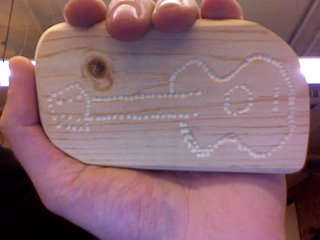Week 1 & 2: Intro and Venus
There are two main reason I decided to study wearable technology: first, I see I lot of very interesting possibilities in the realm of portable, comfortable devices; secondly, I think it's crucial to able to design with the human body in mind, becuase given an option, people will pick the product that feels right.
So with these thoughts in mind, I took on the task of creating my own Venus of Willendorf. A few things struck me about the Venus . It seemed to be an object that fit well into the hand, was comfortable to grasp, and I thought of all the things that only our hands can do. Thus, I decided to take a block of wood and carve it to fit specifically in my hand. I chose wood because, besides being nice to work with and nice to hold, it also changes over time, absorbing oils and moisture from the body, effectively taking on some aspects of its owner.
Front
Back
The guitar, meant to symbolize an important, personal (but non-portable) object was hammered into the wood using a metal punch. As you can see, my drawing skills leave much to be desired. However, the shape and the grooves for the fingers and palm proved to be quite effective in nestling the wood into my hand.I thought this was a great excercise; I spent a lot of time just thinking about my hands, the impressions they make, the spatial relationships that work well with them, and how hard it is to make an object that works for one hand, let alone many.
As for the first set of readings and discussion, a few points stuck out in particular for me. In the Fashion article by George Simmel, I was particularly interested in his discussion of fashion as it relates to class, espically in light of the time in which he was writing versus today. The idea that fashion trends are set by the rich and immitated by the poor certainly has some credibility; just think of all the direct imitations of pricey label items (Louis Vuitton bags, Oakley Sunglasses, fake diamonds, etc.). However, while this is still certainly true, today there are some striking counter-examples. For example, the prevelance of 'urban' style (baggy pants, oversized shirts and jerseys, sneakers), or the rise of pre-ripped or dyed jeans that make them look old and worn right off the rack. These are certainly not styles inspired or designed by the upper class.



0 Comments:
Post a Comment
<< Home